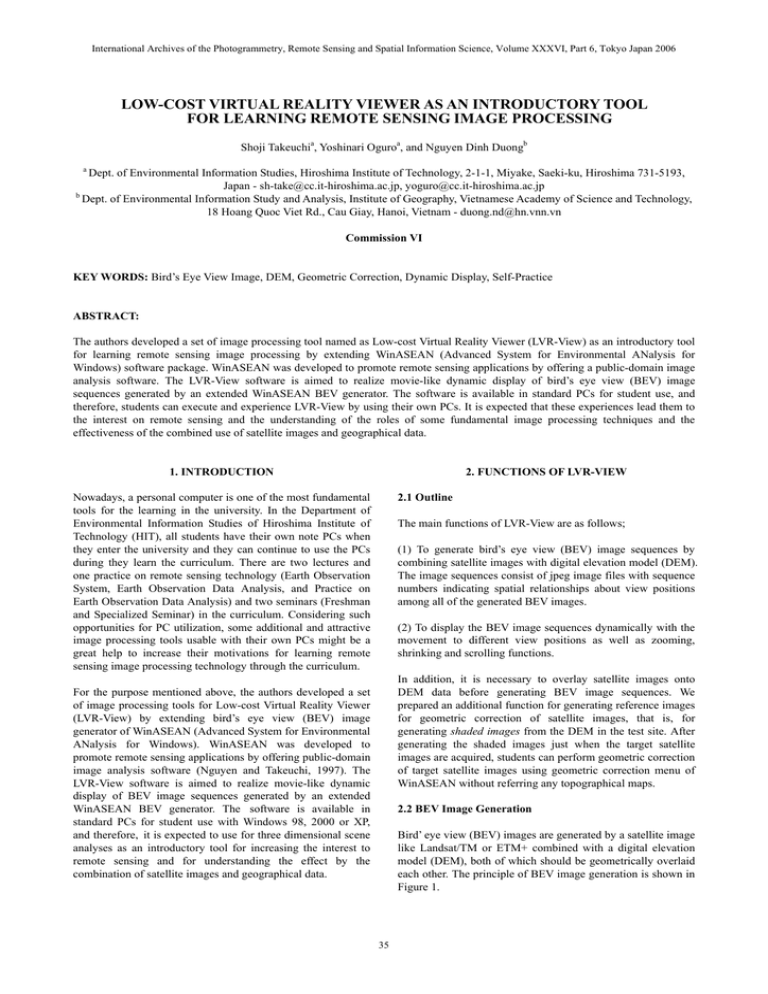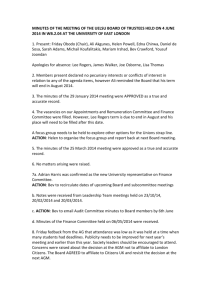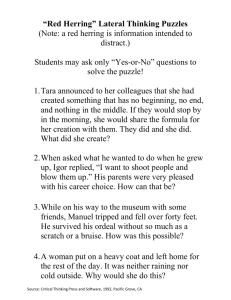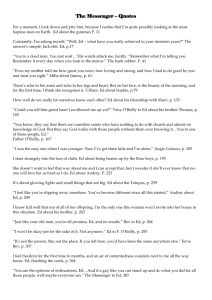LOW-COST VIRTUAL REALITY VIEWER AS AN INTRODUCTORY TOOL
advertisement

International Archives of the Photogrammetry, Remote Sensing and Spatial Information Science, Volume XXXVI, Part 6, Tokyo Japan 2006 LOW-COST VIRTUAL REALITY VIEWER AS AN INTRODUCTORY TOOL FOR LEARNING REMOTE SENSING IMAGE PROCESSING Shoji Takeuchia, Yoshinari Oguroa, and Nguyen Dinh Duongb a Dept. of Environmental Information Studies, Hiroshima Institute of Technology, 2-1-1, Miyake, Saeki-ku, Hiroshima 731-5193, Japan - sh-take@cc.it-hiroshima.ac.jp, yoguro@cc.it-hiroshima.ac.jp b Dept. of Environmental Information Study and Analysis, Institute of Geography, Vietnamese Academy of Science and Technology, 18 Hoang Quoc Viet Rd., Cau Giay, Hanoi, Vietnam - duong.nd@hn.vnn.vn Commission VI KEY WORDS: Bird’s Eye View Image, DEM, Geometric Correction, Dynamic Display, Self-Practice ABSTRACT: The authors developed a set of image processing tool named as Low-cost Virtual Reality Viewer (LVR-View) as an introductory tool for learning remote sensing image processing by extending WinASEAN (Advanced System for Environmental ANalysis for Windows) software package. WinASEAN was developed to promote remote sensing applications by offering a public-domain image analysis software. The LVR-View software is aimed to realize movie-like dynamic display of bird’s eye view (BEV) image sequences generated by an extended WinASEAN BEV generator. The software is available in standard PCs for student use, and therefore, students can execute and experience LVR-View by using their own PCs. It is expected that these experiences lead them to the interest on remote sensing and the understanding of the roles of some fundamental image processing techniques and the effectiveness of the combined use of satellite images and geographical data. 2. FUNCTIONS OF LVR-VIEW 1. INTRODUCTION 2.1 Outline Nowadays, a personal computer is one of the most fundamental tools for the learning in the university. In the Department of Environmental Information Studies of Hiroshima Institute of Technology (HIT), all students have their own note PCs when they enter the university and they can continue to use the PCs during they learn the curriculum. There are two lectures and one practice on remote sensing technology (Earth Observation System, Earth Observation Data Analysis, and Practice on Earth Observation Data Analysis) and two seminars (Freshman and Specialized Seminar) in the curriculum. Considering such opportunities for PC utilization, some additional and attractive image processing tools usable with their own PCs might be a great help to increase their motivations for learning remote sensing image processing technology through the curriculum. The main functions of LVR-View are as follows; (1) To generate bird’s eye view (BEV) image sequences by combining satellite images with digital elevation model (DEM). The image sequences consist of jpeg image files with sequence numbers indicating spatial relationships about view positions among all of the generated BEV images. (2) To display the BEV image sequences dynamically with the movement to different view positions as well as zooming, shrinking and scrolling functions. In addition, it is necessary to overlay satellite images onto DEM data before generating BEV image sequences. We prepared an additional function for generating reference images for geometric correction of satellite images, that is, for generating shaded images from the DEM in the test site. After generating the shaded images just when the target satellite images are acquired, students can perform geometric correction of target satellite images using geometric correction menu of WinASEAN without referring any topographical maps. For the purpose mentioned above, the authors developed a set of image processing tools for Low-cost Virtual Reality Viewer (LVR-View) by extending bird’s eye view (BEV) image generator of WinASEAN (Advanced System for Environmental ANalysis for Windows). WinASEAN was developed to promote remote sensing applications by offering public-domain image analysis software (Nguyen and Takeuchi, 1997). The LVR-View software is aimed to realize movie-like dynamic display of BEV image sequences generated by an extended WinASEAN BEV generator. The software is available in standard PCs for student use with Windows 98, 2000 or XP, and therefore, it is expected to use for three dimensional scene analyses as an introductory tool for increasing the interest to remote sensing and for understanding the effect by the combination of satellite images and geographical data. 2.2 BEV Image Generation Bird’ eye view (BEV) images are generated by a satellite image like Landsat/TM or ETM+ combined with a digital elevation model (DEM), both of which should be geometrically overlaid each other. The principle of BEV image generation is shown in Figure 1. 35 International Archives of the Photogrammetry, Remote Sensing and Spatial Information Science, Volume XXXVI, Part 6, Tokyo Japan 2006 (1) Transformation by azimuth angle (α) X1 = Xcosα + Ysinα Y1 = - Xsinα + Ycosα X α X1 Y1 View Point Y (2) Transformation by depression angle (φ) View Point Z’ Z X’ = X1 = Xcosα + Ysinα Y’ = Y1sinφ - Zcosφ = ( - Xsinα+Ycosα)sinφ - Zcosφ Z’= Y1cosφ + Zsinφ = ( - Xsinα+Ycosα)cosφ + Zsinφ Figure 2. An example of BEV images of Hiroshima City. In this BEV image, ground height values are enhanced two times. φ three-digit represents azimuth angle values. The ranges and intervals for azimuth and depression angles are specified when BEV image sequences are generated. φ Y1 Then a special BEV image viewer was developed to display the BEV image sequences according to the number sequences. The number sequences are controlled by keyboard (←↑→↓) or mouse movement. Therefore, students can experience movie-like dynamic display of BEV images with the operation of keyboard or mouse. Of course, a large number of BEV images are required for smooth movement in the BEV image viewer, that is, the intervals for azimuth and depression angles should be small (a few degrees) to generate a large number of images, usually more than one thousand images. Some optional functions for zooming, shrinking, and scrolling are also available in the BEV image viewer. Y’ (3) Transformation from parallel to central projection View Point (Y’’ - Y’) : Z’ = Y’’ : d ∴ Y’’ = Y’d / (d - Z’) (X’’ - X’) : Z’ = X’’ : d ∴ X’’ = X’d / (d - Z’) d Z’ Y’ Figure 1. Principle of BEV image generation 2.4 Geometric Correction Using Shaded Image Y’’ The pre-processing of satellite images, namely the geometric correction of satellite images, is required to realize BEV image generation. This process is actually the most difficulty for the beginners of remote sensing image processing. In the regular practice on earth observation data analysis, the geometric correction has been conducted with the digital map issued by GSI. However, one digital map consists of 1 to 25,000 scale topographical map, and much higher resolution (al least two or three meters) than that for satellite images is required to select GCPs from the digital map and thus the data volume of the digital map becomes very large. For example, if we want to generate BEV images of Hiroshima City shown in Figure 2, we need to select GCPs from the map image with the volume more than 400 MB. This means actual difficulty to perfom efficient geometric correction with the PCs for student use. In Figure 1, three parameters, azimuth angle (α), depression angle (φ), and distance (d), are required to assign to generate a BEV image. In WinASEAN BEV generator, students can assign any values for these three parameters, and after that they can check the result of BEV image generation quickly in the same menu. Figure 2 shows an example of BEV images of Hiroshima-City generated from Landsat-7/ETM+ image and 50 meters mesh DEM issued by Geographical Survey Institute of Japan (GSI). 2.3 BEV Image Viewer Although students can view the BEV images quickly after assigning necessary parameters, it still takes several seconds at least for generating one BEV image with the PCs for student use, and this means that at the moment true virtual reality cannot be realized with their own PCs. Therefore, a special image viewer was developed for dynamic display of BEV images which are previously generated by BEV generator of WinASEAN. In order to realize more efficient processing for geometric correction, we chose the alternative approach with shaded images which are generated from DEM and reflect the shaded conditions just for the time of satellite observation (Takeuchi and Oguro, 2002). Figure 3 shows the shaded image for Landsat-7/ETM+ image acquired on April 10, 2003, and the geomerically corrected ETM+ image by using the shaded image as a reference. As the size of a shaded image is equal to that of the original DEM image, the geometric correction process becomes a simple process, that is, overlaying of the satellite image onto the shaded image by extracting appropriate image to image tie point pairs. First the BEV generator of WinASEAN was extended to generate a set of BEV images (BEV image sequences) which consist of jpeg image files with the numbered file names corresponding to the values for azimuth and depression angles. Actually the numbered file names consist of five-digit numbers, first two-digit represents depression angle values and next 36 International Archives of the Photogrammetry, Remote Sensing and Spatial Information Science, Volume XXXVI, Part 6, Tokyo Japan 2006 Import Landsat image to WinASEAN Generate shaded image from DEM data Import shaded image to WinASEAN Geometric correction using shaded image Import DEM data to WinASEAN Confirm BEV image generation Shaded image for ETM+ image Generate BEV image sequences Experience LVR-View with BEV image sequences Submit report of practice results Figure 4. Data processing flow for self-practice on LVR-View. Geometrically corrected ETM+ image Figure 3. Shaded image and geometrically corrected image for Landsat-7/ETM+ data acquired on April 10,2003. 3. SELF-PRACTICE ON LVR-VIEW 3.1 Time for Self-Practice on LVR-View Figure 5. A scene of self-practice on LVR-View with their own PCs in a seminar room. In the Department of Environmental Information Studies of HIT, the practice on earth observation data analysis is held in the former semester of third-year. This practice consists of three kinds of fundamental subjects, geometric correction of satellite images, multi-spectral image analysis by vegetation index and maximum likelihood classification, and surface temperature extraction from a thermal-band image. As it takes rather long time (several hours) for generating BEV image sequences, it is difficult to execute every practice in the regular scheduled period at the moment and therefore they need to complete the practice as their home works. However, in near future, it will be possible to complete total practice in a scheduled period according to the grade-up of computation power of PCs. Figure 5 shows a scene for self-practice by students with their own PCs. In addition, students should use the special software for generating shaded images at the moment. This software might be included as one of the menus of WinASEAN to execute more efficient geometric correction in near future. At the moment, the practice on LVR-View is held in the later semester after above regular practice for the students belonging to the author’s seminar, because at least the basic concept for geometric correction is necessary for the self-practice on LVR-View. However in near future, LVR-View might be possible to be included as one of the subjects of the regular practice. In addition, in the freshman seminar, which is held in the former semester of first-year, a brief demonstration of LVR-View, that is, the experience of LVR-View by pre-generated BEV image sequences with their own PCs, is presented to students. 3.3 Effect of Practice on LVR-View The geometric correction is one of the most fundamental image processing techniques necessary for various practical applications of satellite images. However, generally this procedure needs patience especially for the beginners. LVR-View possibly offers the importance and effect of the geometric correction due to its attractive result. In addition, LVR-View suggests the effect of the combination of satellite images and auxiliary GIS data. The understanding for the importance and the effect of the geometric correction and the combined use of satellite images with GIS data might be a great help to lead students to the research on remote sensing image analysis in their graduation theses. 3.2 Method for Self-Practice on LVR-View Figure 4 shows the data processing flow for the self-practice on LVR-View by students with their own PCs. Students should complete the practice by themselves, although some auxiliary information, data specifications of satellite images and DEM, observation date of the satellite image, and the principle for the generation of shaded images etc., is presented by text or Word documents. 37 International Archives of the Photogrammetry, Remote Sensing and Spatial Information Science, Volume XXXVI, Part 6, Tokyo Japan 2006 4. LVR-VIEW AS A TOOL FOR RESEARCH Multi-temporal Landsat Images Originally LVR-View was developed as an educational tool for the learning of remote sensing image processing and analysis. However, this system might be possible to use as a tool for the research too. Figure 6 shows the flow chart of a research for the analysis on the topographical conditions of urbanized areas by the combined use of multi-temporal satellite images and DEM (Takeuchi and Oguro, 2003). Figure 7 shows one of the results by this study in Hiroshima and Sendai City. The figures in Figure 7 indicate the occupation rates of slope-classes in newly urbanized areas in both cities. The slope-classes are obtained from the slope angles computed from DEM by dividing them in 5 degrees interval. Geometric Correction Digital Elevation Model (DEM) Generation of Shading Image Extraction of Land Cover Change Computation of Slope Angle Generation of Slope-class Image Mask Operation & Statistics Figure 6. Flow chart of the research for the analysis on the topographical conditions of urbanized areas. The result in Figure 7 means that the slope conditions for newly urbanized areas are much more severe in Hiroshima than in Sendai, because the rate for urbanized areas developed in steep slope is much higher in Hiroshima than in Sendai. Figure 8 shows the examples of the results by LVR-View, in which BEV image sequences are generated in both cities by using same parameters for BEV image generation. Therefore, the difference of the topographical conditions in two cities is easily understandable by Figure 8. Actually Figure 8 is only one scene by LVR-View, and the difference can be recognized in more realistic manner by the experience of real LVR-View. Figure 7. Occupation rates of slope-classes in newly urbanized areas in Sendai and Hiroshima City. 5. CONCLUSION Sendai The authors developed a set of image processing tools for Low-cost Virtual Reality Viewer (LVR-View) as an introductory tool for the learning of remote sensing image processing and analysis. The most attractive point is that students can execute and experience LVR-View by using their own PCs. It is expected that these experiences lead them to the interest to remote sensing and the understanding of the role of some fundamental image processing techniques and the effectiveness of the combined use of satellite images and GIS. In near future, more powerful tool should be developed to realize more attractive event on remote sensing image analysis and application. Hiroshima ACKNOWLEDGEMENT This study is conducted as a part of Academic Frontier Project of Hiroshima Institute of Technology on Generation of Advanced Earth Environmental Information supported by matching fund subsidy from Ministry of Education, Culture, Sports, Science and Technology. Figure 8. Examples from LVR-View in Sendai and Hiroshima City. Above two BEV images are generated with the same values for depression angles and with three times enhancement of ground height values. REFERENCES Nguyen D.D. and S.Takeuchi, 1997. WinASEAN for remote sensing data analysis. ISPRS Journal of Photogrammetry & Remote Sensing 52 (1997) 253-260. Takeuchi S. and Y.Oguro, 2003. Analysis on Topographical Aspect in Urban Growth by Combining Multi-Temporal Landsat Images and DEM. The International Archives of The Photogrammetry, Remote Sensing and Spatial Information Sciences, Vol XXXIV-7/W9, Regensburg, Germany. Takeuchi S. and Y.Oguro, 2002. Geometric Correction of Satellite Images by Using Shaded Images and Regression Model (in Japanese). Proceedings for The 32th Conference of Remote Sensing Society of Japan, P-36, 169-170. 38



